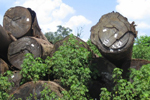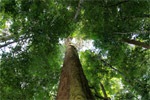Advocates for reduced impact logging in tropical forests often make a case that better forest management cuts carbon emissions relative to traditional forms of timber harvesting. While the argument for altering logging approaches to limit forest damage makes intuitive sense, a new study suggests that the carbon benefits may not bear out in practice.
Bronson Griscom and Peter Ellis of The Nature Conservancy (TNC) and Jack Putz of the University of Florida evaluated nine sites in logging concessions in Indonesian Borneo, measuring the width of logging trails and the mass of trees damaged by harvesting. From that work they estimated emissions associated with reduced impact logging (RIL) and compared them with conventional logging.
What they found was a surprise: reduced impact logging — at least as practiced in the Indonesian concessions — did not meaningfully reduce emissions relative to conventional logging.
“We found that concessions certified by the Forest Stewardship Council (FSC, N = 3), when compared with noncertified concessions (N = 6), did not have lower overall CO2 emissions from logging activity (felling, skidding, and hauling),” they write.
 Conventional logging in Borneo. Photo by Rhett A. Butler.
Conventional logging in Borneo. Photo by Rhett A. Butler.
The problem, say the authors, is that reduced impact logging practices aren’t being employed on the ground, due in part to conflicting incentives. A blog post from TNC explains: “The authors identified four practices that do improve emissions performance, but they are not all recognized as RIL and not applied consistently, even on RIL concessions. If implemented together, these four practices could reduce carbon emissions from logging in Indonesia by about 50 percent, without reducing wood production.”
Opportunities include cutting only usable trees, leaving ecologically valuable hollow trees standing; using cables rather than bulldozers to drag logs out of the forest; and employing directional felling to minimize biomass losses. The authors note that while reduced impact logging doesn’t explicitly target emissions reductions, focusing on the issue “points to important gaps in existing reduced impact logging schemes.”
“To clarify the relationship between RIL and emissions reductions, we propose the more explicit term ‘RIL-C’ to refer to the subset of RIL practices that can be defined by quantified thresholds and that result in measurable emissions reductions,” they write. “If tropical forest certification is to be linked with CO2 emissions reductions, certification standards need to explicitly require RIL-C practices.”
Nonetheless, the results cast doubt on whether reduced impact logging should receive payments under REDD+. Griscom and colleagues argue that simple fixes could result in real emissions reductions, but the question is whether these fixes will be actually implemented on the ground, especially in poorly-monitored concessions like those studied in Kalimantan. The danger is REDD+ could effectively subsidize logging in high carbon stock forests like old-growth rainforests without cutting emissions, while degrading the biological value and ecological resilience of the area.

Old growth rainforest in Borneo
Bill Laurance of James Cook University says he’d rather see REDD+ funds used for purposes other than subsidizing logging in primary forests.
“Rather than trying to use REDD+ funds to lower carbon emissions from logging, I’d rather see such funds used to purchase previously logged forests or to protect them from conversion,” Laurance told Mongabay.com. “For instance, Indonesia alone has at least 35 million hectares of logged forest, large expanses of which is being cleared for oil palm or wood pulp. These logged forests still retain a lot of biodiversity and carbon, and because most of their marketable timber is gone they could be very cost-effective purchases to reduce emissions and save biodiversity.”
Corey Bradshaw of the University of Adelaide agreed with Laurance.
“It’s insane to consider ‘lower-emission’ logging at all considering the forests, no matter the disturbance, are never able to retain as much carbon or biodiversity as primary forests,” Bradshaw told mongabay.com. “As we found in the Gibson et al. paper in Nature, absolutely nothing can replace the value of primary forest.”
CITATION: Griscom, B., P. Ellis & F.E. Putz. 2014. Carbon emission performance of commercial logging in East Kalimantan, Indonesia. 2014. Carbon emissions performance of commercial logging in East Kalimantan, Indonesia. Global Change Biology, 20:3. doi: 10.1111/gcb.12386
Related articles
Zero net deforestation is the wrong target, warn experts

(11/14/2013) Environmental initiatives that target zero net deforestation may miss their mark when it comes to slowing climate change and protecting biodiversity, warns a commentary published in this week’s issue of the journal Science. While zero net deforestation may seem like a worthy target in efforts to curb forest loss, Sandra Brown and Daniel Zarin argue that the goal is at best, ambiguous, and at worst, may lead to perverse outcomes for the world’s forests.
Old-growth trees store half rainforest carbon

(08/07/2013) Large trees store store up to half the above-ground biomass in tropical forests, reiterating their importance in buffering against climate change, finds a study published in Global Ecology and Biogeography. The research, which involved dozens of scientists from more than 40 institutions, is based on data from nearly 200,000 individual trees across 120 lowland rainforest sites in Africa, Asia, and Latin America. It found that carbon storage by big trees varies across tropical forest regions, but is substantial in all forests.
Experts: sustainable logging in rainforests impossible

(07/19/2012) Industrial logging in primary tropical forests that is both sustainable and profitable is impossible, argues a new study in Bioscience, which finds that the ecology of tropical hardwoods makes logging with truly sustainable practices not only impractical, but completely unprofitable. Given this, the researchers recommend industrial logging subsidies be dropped from the UN’s Reducing Emissions from Deforestation and Forest Degradation (REDD+) program. The study, which adds to the growing debate about the role of logging in tropical forests, counters recent research making the case that well-managed logging in old-growth rainforests could provide a “middle way” between conservation and outright conversion of forests to monocultures or pasture.
Greenpeace calls for global REDD standards to reduce negative impacts of forest carbon projects
(06/26/2012) Greenpeace has launched a consultation process to establish global standards for Reducing Emissions from Deforestation and Degradation (REDD+) projects.
Logging of primary rainforests not ecologically sustainable, argue scientists

(01/25/2012) Tropical countries may face a risk of ‘peak timber’ as continued logging of rainforests exceeds the capacity of forests to regenerate timber stocks and substantially increases the risk of outright clearing for agricultural and industrial plantations, argues a trio of scientists writing in the journal Biological Conservation. The implications for climate, biodiversity, and local economies are substantial.

(06/09/2009) A global framework on climate change must immediately halt deforestation and industrial logging of the world’s old-growth forests, while protecting the rights of forest communities and indigenous groups, said a broad coalition of activist groups in a consensus statement issued today at U.N. climate talks in Bonn Germany. The statement said the successor treaty to the Kyoto Protocol should not include mechanisms that allow industrialized countries to “offset” their emissions by purchasing carbon credits from reducing deforestation in developing countries, a position that puts the coalition at odds with larger environmental groups who say a market-based approach with tradable credits is the only way to generate enough money fund forest protection on a global scale.







